I Spy Lucy Boxes
A note by Frank Sharman, Bev Parker and Duncan Nimmo with help from Cathy
Dennis, John Hughes, Sue Whitehouse, Ros Doran, Neville Baker, Phillip Hornby,
Phillip Horton, David Plant, Keith Nutter, Henry Brown, Keith Pople and
Alec Hamilton.
| In 2002 an entertaining new game, I Spy Lucy Boxes, was
initiated by Mike Stafford Good, who asked Judith Rowley, Chair of
the City's planning committee, what could be done to enhance and
preserve the cast iron boxes, decorated with the city's coat of
arms, that can be seen at various places round town. A city
centre example was noted outside Endsleigh Insurance in Princes
Square but, as Sue Whitehouse says, once you see one, you see them
everywhere.
As you will see from the account below, the game has now
advanced to a serious attempt to preserve some of this
interesting and important street furniture.
"Lucy box" is a name applied to boxes, about 3 feet high, about
2 feet wide and about 18 inches deep, which are to be found on
pavements throughout the city. Such boxes were originally used
in connection with the tram network and then with the trolley
bus network; and as part of the general electricity supply
network; and for telephone purposes.
|
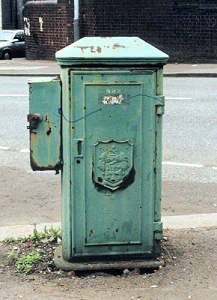
A typical box - but with a bolt on extra of unknown function. |
They are usually green, which was the standard colour used by
the local electricity department, as is shown on the green doors
and railings of their substations (shown elsewhere on this
site). Keith Nutter, or GPU Power, tells us that, when the
boxes had come into the ownership of the MEB, they painted
them silver, which was their standard colour. A few of
them are now black, but that is usually due to the Council
painting them that colour to match the rest of the street
furniture in the area. These days they are usually thickly
coated with layers of paint, which is now chipped, and often
covered with graffiti; and often they are used for fly
posting. There are cases, such as the Lucy name plate shown
below, where you can still see the old green colour showing up
under the later silver paint.
The name "Lucy box" was applied to these boxes because the
great majority of them, in the early days at least, were made by
the Lucy Foundry in Oxford. |
| The Lucy Group of companies, which started in 1803,
is still in active operation, based in Oxford, though a lot of their
manufacturing now takes place in Dubai. They specialise in
electrical equipment, making equipment from that for large scale use
down in size to that for domestic use.
One of their products was a cast iron box, about two feet
wide, 18 inches deep and three feet high, with a pyramidal top,
and a lockable door on each side.
The equipment inside such a box would typically be either a
junction for power supply or an isolator for transport
systems.
Lucy still make and sell what they call "service pillars",
including cast iron ones. |
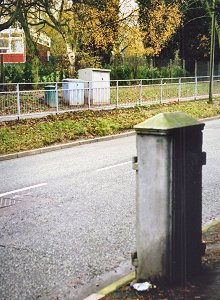
A traditional box with a
selection of other boxes on the other side of Finchfield Hill. |
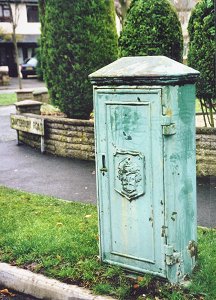 A box in a suburban setting - at the
bottom of Canterbury Road.
A box in a suburban setting - at the
bottom of Canterbury Road. |
The company almost invariably cast its name, in the form of
"Lucy Oxford", on the outside of such boxes. There was also a
feeling among our informants (expressed by one person as an
absolute positive) that boxes made by Lucy always had their
maker's name on them. If it does not say Lucy on the outside,
then one should look inside. Lucy's could also cast any other
name or emblem on the box for the customer.
It seems that the Lucy Company could provide pillars on their
own or fully equipped with whatever electrical gear was
wanted.
But similar boxes and the electrical equipment inside them
could have been made by any electrical engineering company, with
or without the assistance of a local foundry. An obvious
candidate would be ECC of Wolverhampton. Boxes by
different makers have now been noted around the city.
|
|
But because of the company name which appeared on so many of
them, such boxes are often known as Lucy boxes, whether they
were made by Lucy or not. And although the company calls
them service pillars, those who use them often refer to them by
their use, for example, isolation pillars or isolation boxes.
Lucy boxes in a transport system are "section pillars". The equipment
in them was used to isolate a section of the tram or trolley bus route -
that is, to stop electricity running through that section. It could also
be used to "make the route solid", that is, you could make the electric
current bypass the isolating components in the box; this would enable
you to work on the box while the trams or trolleys continued running.
Legislation required that there should be an isolator on
transport routes at least every half mile. This requirement
applied to all tram systems and must have applied to
Wolverhampton's Lorraine system, and to the later dual standard
system and to the trolley bus system. |
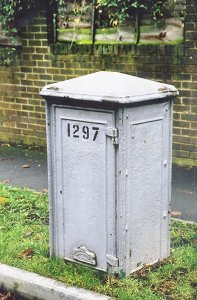
A box identifiable as a Lucy
service pillar by the maker's name on a separately cast plate at the
foot. This one is at the top of Canterbury Road. |
|
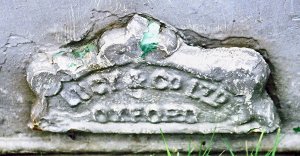 The maker's name plate.
The maker's name plate. |
Therefore if you are trying to identify a Lucy box
connected with a transport system you have to look for a box on a
road which was on a tram or trolley bus route.
We would add that one informant said that the section pillars
on the old tram routes had "the old coat of arms" on them. |
|
There are several boxes, of similar shapes and sizes, and of all ages,
which look just like section pillars, and which have the Borough coat of
arms on them, on roads which were never tram or trolley bus routes.
The feeling of our informants from the old MEB was that many surviving
boxes were not made by Lucy and were for electricity distribution and
never were anything to do with transport.
Early boxes had a door at both sides and had to stand in the middle of
the pavement. Later ones could be used from one side, had only one door
and could stand against a wall. |

On the left is one of the
candidates for the oldest Lucy box in the city. It stands at
the corner of Waterloo Road and Darlington Street. The coat of arms
on it is that used by the Borough up until 1898. Note the decoration
on the top. |
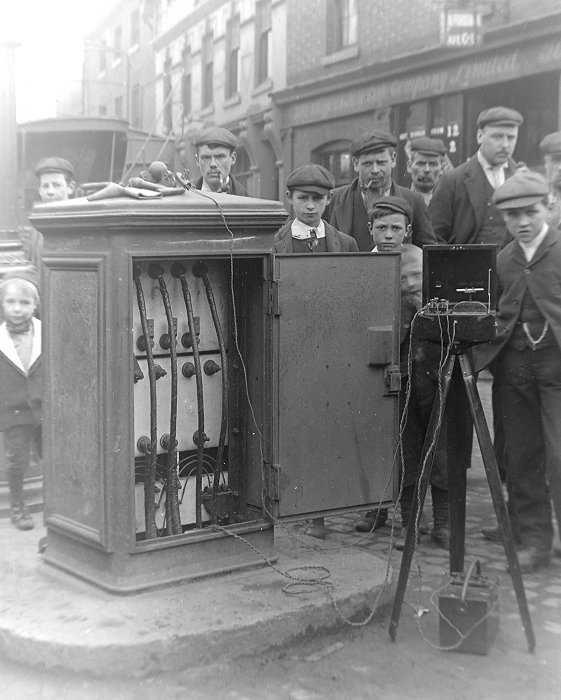
This lovely photo from 1903 was kindly sent by
Cathy Dennis, who owns the copyright. It shows measurements
being taken from a Lucy box at Victoria Square, with Horseley Fields in the background. The measurements were
being taken using a very early form of galvanometer. |
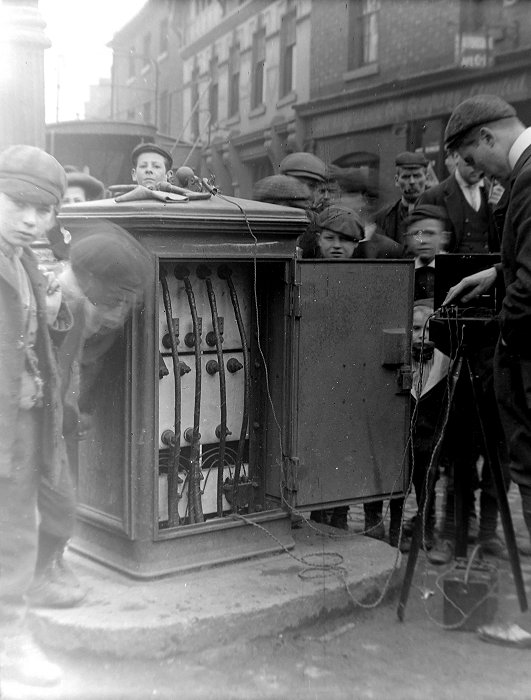
Another lovely photo from 1903,
courtesy of Cathy Dennis, who owns the copyright.
It
is another view of the Lucy box at the top of Horseley
Fields. In those days most people didn't appreciate the
dangers of electricity, especially considering that the
circuitry in the Lucy box operated at 500 Volts DC.
|
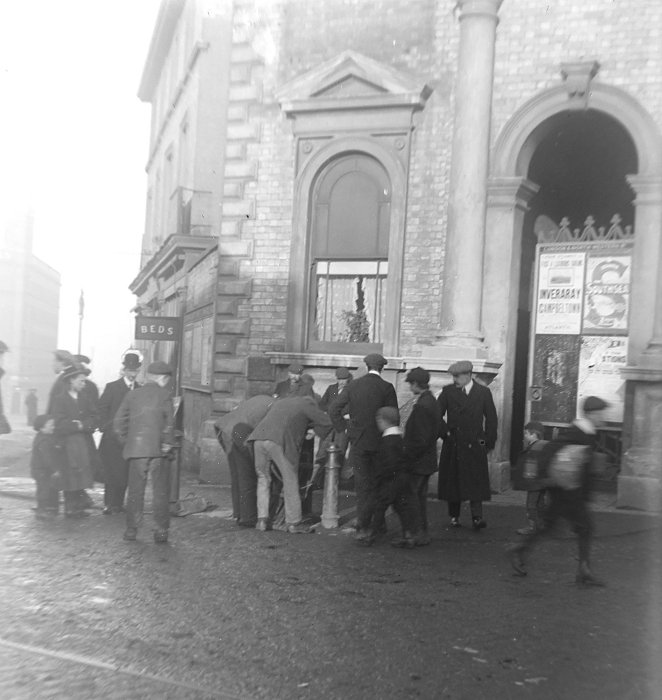
Another of Cathy
Dennis's lovely photos from 1909, for which she owns
the copyright. The people are working on a smaller
Lucy box, 40 metres or so from the one above. The
building in the background is the well-known Queen's
Building, facing Queen Street. |
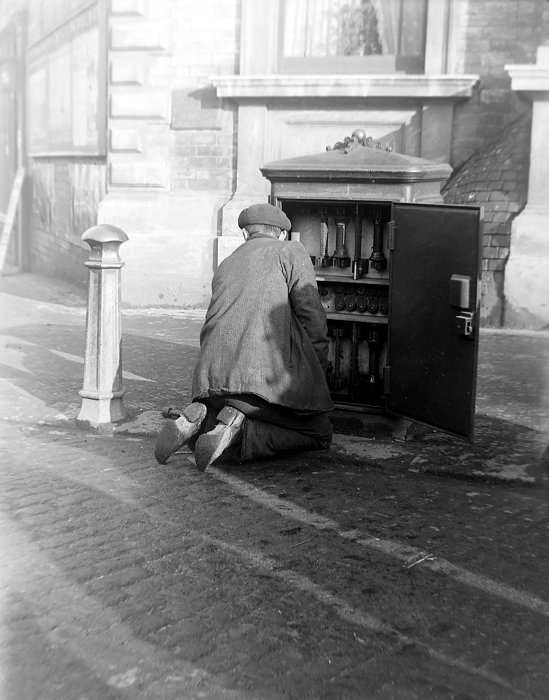
Yet another of Cathy
Dennis's lovely photos from 1909, for which she
owns the copyright. It is another view of the
Lucy box in front of the Queen's Building.
|
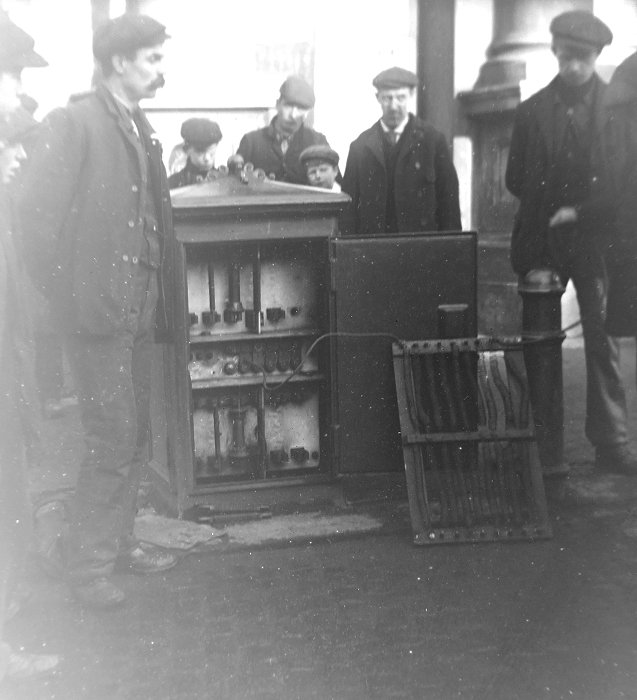
A close-up view of the
same Lucy box, also from 1909. Courtesy of
Cathy Dennis, who owns the copyright. |
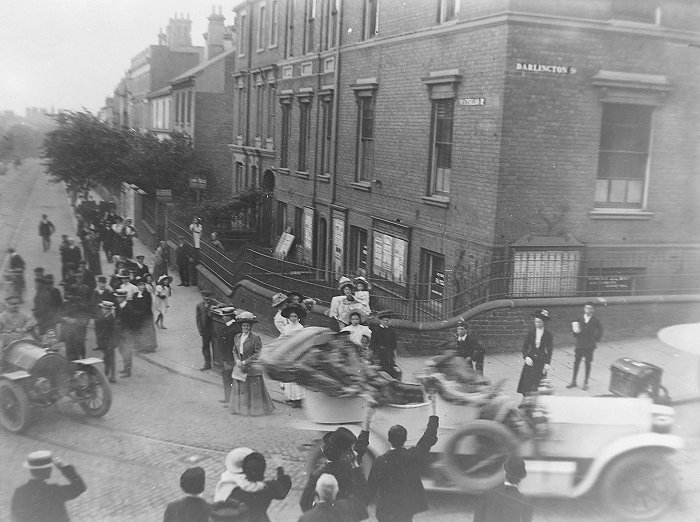
An image from just
before the First World War showing some
visiting dignitaries passing what is
believed to be the first Lucy box, which
was on the corner of Darlington Street
and Waterloo Road. The photo is also
from Cathy Dennis's wonderful
collection, for which she owns the
copyright. |

The Lucy box
that stood on the corner of Snow
Hill and Cleveland Street, where
Wolverhampton market is today. It is
described on the photo, which dates
from 1908, as the Snow Hill feeder
pillar. The photo is also from Cathy
Dennis's wonderful collection, for
which she owns the copyright. |
| Duncan Nimmo has sampled the minutes and reports of the Borough
Council's Electricity Committee, looking at those for 1913/14,
1918/19, 1924/25 and 1930/31. The contain payments to the Lucy
Company for "feeder pillars" - one in 1913/14; none in 1918/19; and
numerous payments in 1924/25. But in 1930/31 they are no
payments to Lucy but several to J. Hill & Son, ironfounders, of
Albion Street, Wolverhampton. |
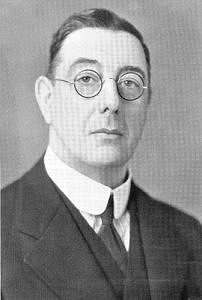 T. A. G. Margary, M.I.E.E., Engineer and
General Manager of the electricity supply undertaking. He
joined the Department sometime between 1913 and 1918 and was
appointed chief in 1920.
T. A. G. Margary, M.I.E.E., Engineer and
General Manager of the electricity supply undertaking. He
joined the Department sometime between 1913 and 1918 and was
appointed chief in 1920. |
In the 1930s a new pattern of box was designed by T A G Margary,
the Borough Electrical Engineer. They were usually called Margary boxes.
Probably the major difference between the old Lucy boxes and the new
Margary boxes was what went inside them. It is also possible that
the extant boxes which carry the borough coat of arms, and are not
marked Lucy, are Margary boxes.
These boxes may not have been made by Lucy - many local foundries were
more than capable of making them and a reference has been found in the
Council's Electricity Committee minutes to payments to J. Hill and Sons
(see above). Inspection of the interiors might show a maker's
mark.
All the boxes which were used for the purposes of electricity supply
became, on nationalisation, the property of the MEB and have now become
the property and responsibility of G. P. U. Power UK. That organisation,
as part of its maintenance and improvement plans, is removing pillars
and replacing them with the underground boxes.
|
|
The suggestion now is that these boxes, which were originally
installed and maintained by the then Borough Council, should be
restored as an interesting contribution to the streetscape.
The boxes need to be stripped of years of accumulated paint
and then repainted, either in black or green, depending on their
surroundings, and with the coat of arms, where present, picked
out in their proper heraldic colours.
There are very large numbers of these boxes and there does not
seem to be much point in trying to preserve all of them.
It would probably be sensible to try to preserve those which are
the oldest; those which have the additional feature of being
associable with the tram or trolleybus system; and those which
are within conservation areas. |
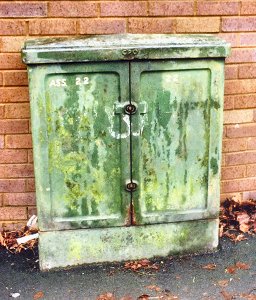 This box is labelled GPO and must be a
telephone junction box.
This box is labelled GPO and must be a
telephone junction box. |
|
Duncan Nimmo has started to pursue this matter and the City Council has
accepted that it would be good to add an appropriate selection to the
list of locally listed buildings and to investigate how their
restoration and preservation might be furthered. Ros Doran of the
Conservation Team is dealing with this.
G.P.U. Power has said that it will not pay for their renovation and
maintenance but they are willing to hand over whatever old boxes the
city council might wish to preserve. They have also been very
helpful in providing lists of their boxes and indicating which are in
line for replacement.
As the streets of the city have been scoured more and more
interesting boxes have come to light; David Plant has taken Duncan Nimmo
on a conducted tour of the boxes preserved at the Black Country Living
Museum; and we have been sent a photo of an historic box now kept by the
Lucy company itself. Some of these are shown on the next page.
|
|


 A box in a suburban setting - at the
bottom of Canterbury Road.
A box in a suburban setting - at the
bottom of Canterbury Road.
 The maker's name plate.
The maker's name plate.







 T. A. G. Margary, M.I.E.E., Engineer and
General Manager of the electricity supply undertaking. He
joined the Department sometime between 1913 and 1918 and was
appointed chief in 1920.
T. A. G. Margary, M.I.E.E., Engineer and
General Manager of the electricity supply undertaking. He
joined the Department sometime between 1913 and 1918 and was
appointed chief in 1920. This box is labelled GPO and must be a
telephone junction box.
This box is labelled GPO and must be a
telephone junction box.